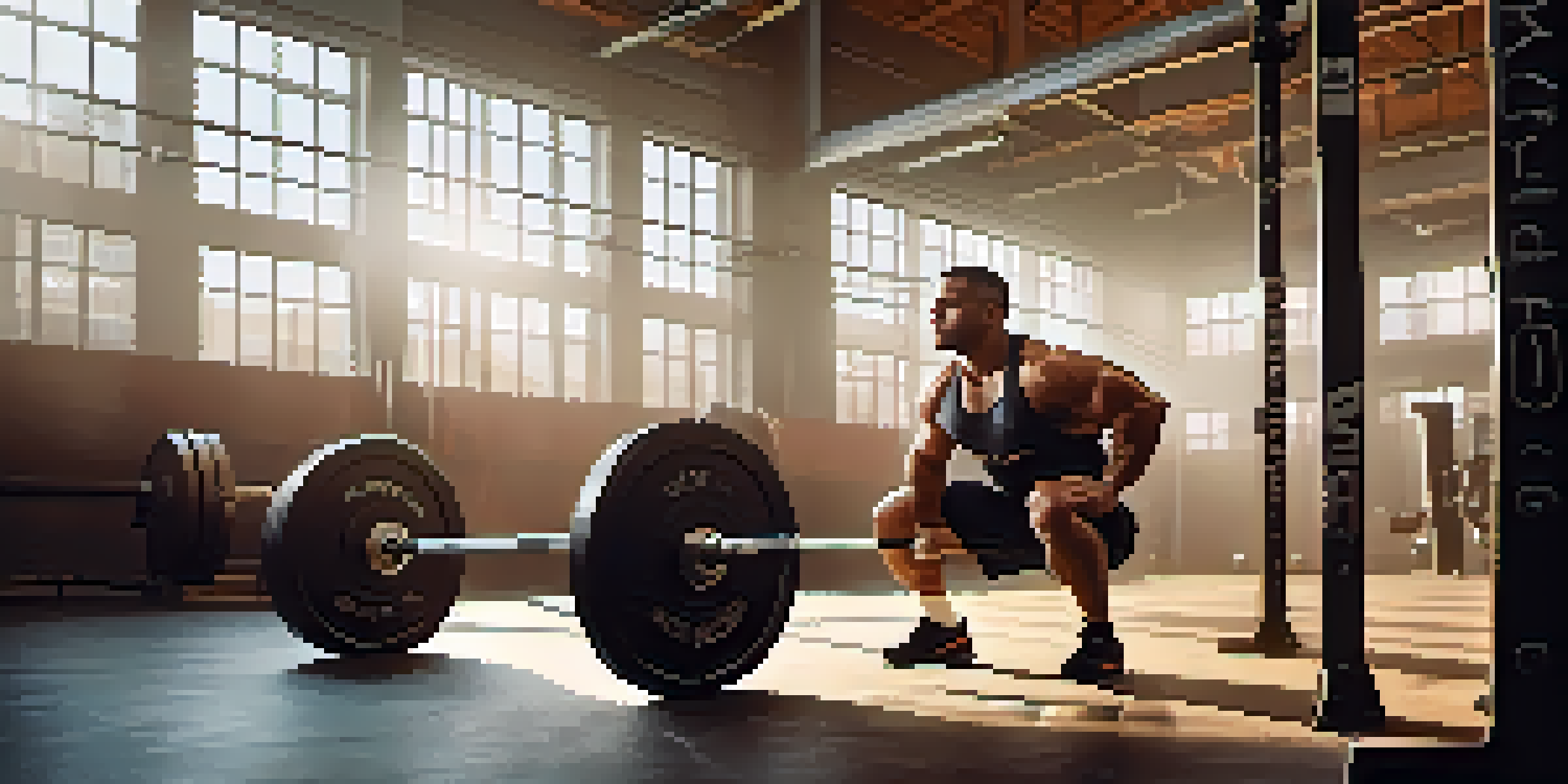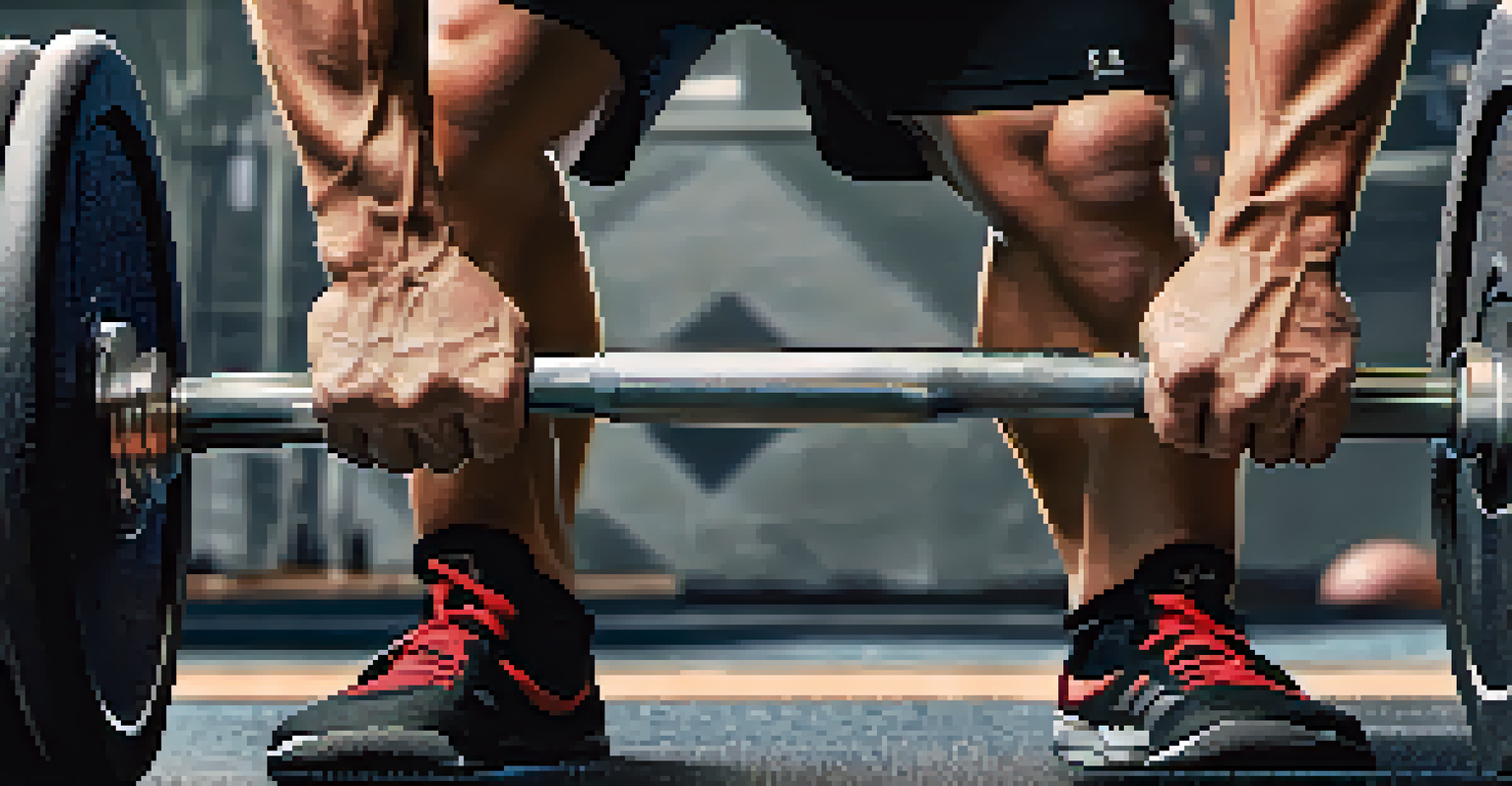Powerlifting Techniques for Enhanced Daily Functionality

Understanding Powerlifting: A Foundation for Daily Strength
Powerlifting focuses on three main lifts: the squat, bench press, and deadlift. These movements are not just for competition; they build foundational strength that translates into everyday activities. Imagine lifting a heavy box or getting up from a low chair; the strength gained from powerlifting can make these tasks feel effortless.
Strength does not come from physical capacity. It comes from an indomitable will.
The beauty of powerlifting lies in its simplicity. By mastering these three lifts, you develop overall body strength, stability, and coordination. It's like building a strong house; the better your foundation, the sturdier your structure will be. This strength can help prevent injuries, making daily activities easier and safer.
Additionally, powerlifting encourages proper lifting techniques. Learning to lift correctly can save you from back pain and muscle strains. Just like a well-tuned engine runs smoother, a body trained in proper mechanics performs daily tasks more efficiently.
The Squat: Enhancing Leg Strength for Everyday Tasks
The squat is one of the most functional exercises you can perform. It mimics the natural movement of sitting down and standing up, which we do countless times each day. By strengthening your legs and core through squats, you're preparing your body for these routine actions, making them easier and more fluid.

Incorporating squat variations, such as front squats or goblet squats, can target different muscle groups, improving your overall strength. Picture yourself carrying groceries or playing with your kids; a strong squat can provide the necessary power and stability for these activities. It's all about enhancing your performance in real-life scenarios.
Powerlifting Builds Daily Strength
Powerlifting's focus on squats, bench presses, and deadlifts enhances foundational strength that makes everyday activities easier.
Moreover, squats help improve your balance and flexibility. As you lower your body, you engage multiple muscle groups, promoting functional mobility. This means that tasks like bending down to tie your shoes become less of a chore and more of a breeze.
The Bench Press: Building Upper Body Strength for Daily Use
The bench press is an essential lift for developing upper body strength, particularly in the chest, shoulders, and triceps. This strength is vital for everyday activities, such as pushing heavy doors or lifting items off high shelves. Think about how often you need to use your arms in daily life; a strong upper body makes these tasks easier.
The difference between a successful person and others is not a lack of strength, not a lack of knowledge, but rather a lack in will.
By incorporating variations like incline or decline bench presses, you can target different areas of the upper body. This diversity not only keeps your workouts interesting but also ensures comprehensive strength development. Imagine being able to lift heavier objects without breaking a sweat; that's the power of a solid bench press routine.
Additionally, the bench press enhances your stability and posture. A strong upper body can lead to better alignment and less fatigue during daily activities. Just like having a sturdy chair to sit on, a strong upper body provides support for everything you do.
The Deadlift: Core Strength for Functional Movement
The deadlift is often considered the king of all lifts because it engages multiple muscle groups, especially in the back and core. This compound movement is crucial for developing the strength needed for picking up heavy objects safely. Think about how often you bend down to pick something up; mastering the deadlift can make this action more efficient and safer.
As you learn proper deadlifting techniques, you'll enhance your body mechanics, which can reduce the risk of injury during everyday tasks. Picture lifting a suitcase or moving furniture; with a strong deadlift, you'll be able to handle these situations with confidence and ease.
Proper Technique Prevents Injuries
Learning correct lifting techniques in powerlifting not only improves performance but also reduces the risk of injuries during daily tasks.
Moreover, deadlifts contribute to better posture and core stability. A strong core supports your spine during various activities, making it easier to maintain good form. It's like having a strong support beam in a building; it keeps everything aligned and secure.
Incorporating Accessory Lifts for Balanced Strength
While the three main lifts are crucial, accessory lifts can enhance your overall strength and functionality. Movements like rows, lunges, and shoulder presses target specific muscle groups that support your primary lifts. Think of these accessory lifts as the seasoning that enhances the flavor of your meal; they make your workouts more complete.
These additional lifts help address muscle imbalances, ensuring that your body remains well-rounded and functional. For instance, incorporating rows can improve your posture, which is essential for everyday activities like sitting at a desk or driving. A balanced body is less prone to injuries and can perform daily tasks with greater ease.
Furthermore, accessory lifts can keep your training routine fresh and engaging. By mixing in different exercises, you can avoid plateaus and maintain motivation. It's like adding variety to your diet; it keeps things interesting while ensuring you get all the nutrients you need.
Prioritizing Recovery for Optimal Performance
Recovery is a critical aspect of any training regimen, especially in powerlifting. Giving your body time to rest and repair is essential for strength gains and overall functionality. Think of recovery as the downtime a computer needs to run smoothly; without it, performance can suffer.
Incorporating rest days, proper nutrition, and hydration into your routine can enhance your recovery process. This means listening to your body and recognizing when it needs a break. Just like a battery needs to be recharged, your muscles need time to recover to perform at their best during daily activities.
Nutrition Fuels Powerlifting Success
A balanced diet with the right macronutrients is essential for supporting powerlifting efforts and enhancing overall daily functionality.
Additionally, practices such as stretching, foam rolling, and even yoga can complement your recovery efforts. These activities promote flexibility and reduce muscle tension, helping you feel more limber and ready for the day ahead. Embracing recovery means you're investing in your long-term health and functionality.
Nutrition: Fueling Your Powerlifting Journey
Proper nutrition plays a vital role in supporting your powerlifting efforts and enhancing daily functionality. Consuming the right balance of macronutrients—proteins, carbohydrates, and fats—can help fuel your workouts and recovery. Imagine your body as a car; it needs the right fuel to run efficiently and perform at its best.
Protein is particularly important for muscle repair and growth, while carbohydrates provide the energy needed for intense training sessions. Including whole foods like lean meats, fruits, and vegetables in your diet can help you achieve optimal performance. It's all about giving your body the tools it needs to succeed.

Moreover, staying hydrated is essential for overall health and performance. Water plays a crucial role in muscle function, recovery, and even mental clarity. Just like a plant needs water to thrive, your body requires hydration to maintain peak performance in both lifting and daily activities.
Setting Goals: A Roadmap to Success in Powerlifting and Life
Setting clear, achievable goals is key to success in powerlifting and enhancing daily functionality. Whether you're aiming to lift a certain weight or improve your endurance, having specific targets gives you direction and motivation. Think of these goals as signposts on a journey; they guide you to your destination.
Using the SMART criteria—Specific, Measurable, Achievable, Relevant, and Time-bound—can help you create effective goals. For example, instead of saying, 'I want to get stronger,' you could set a goal to increase your squat by 20 pounds in three months. This clarity makes it easier to track your progress and stay committed.
Additionally, celebrating small victories along the way can keep you motivated and engaged. Just like a marathon runner celebrates crossing each mile marker, acknowledging your achievements can boost your confidence and encourage you to keep pushing forward. Setting and achieving goals is a powerful way to enhance not just your lifting, but your entire daily functionality.